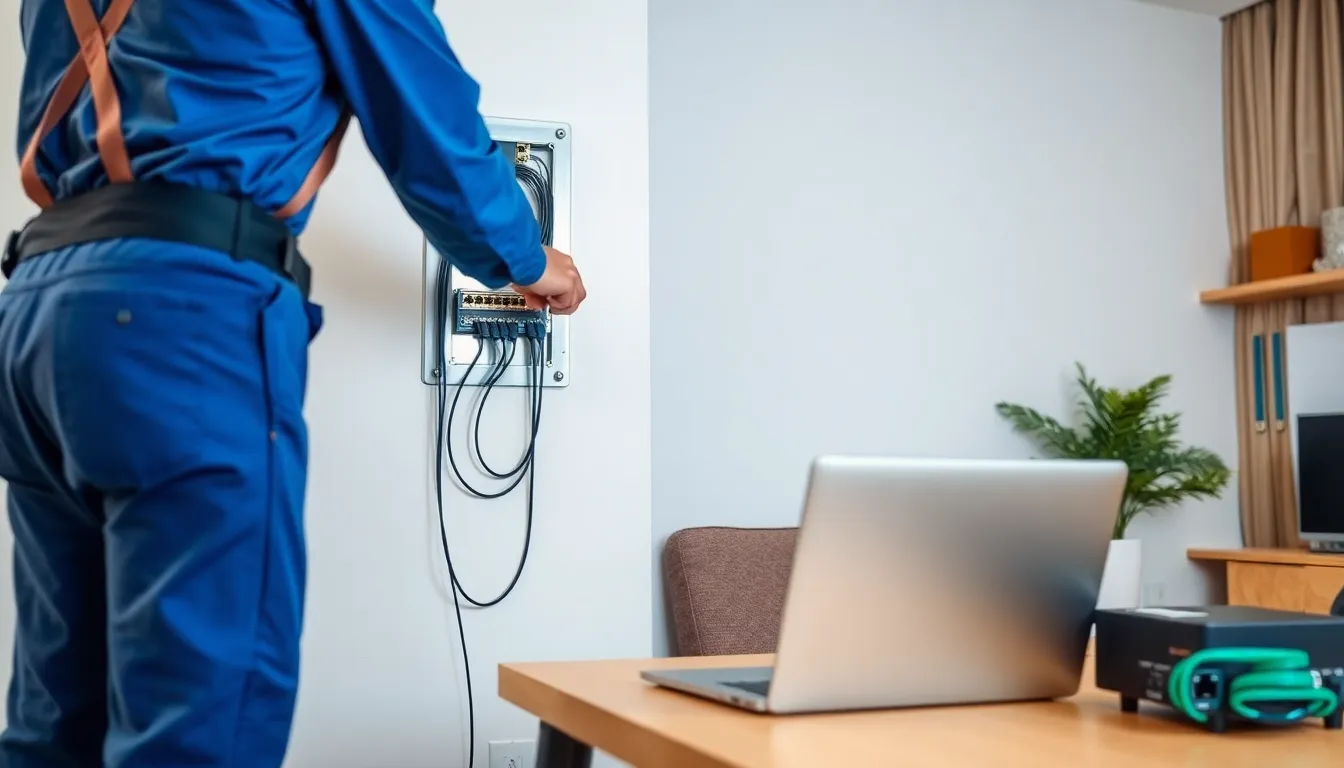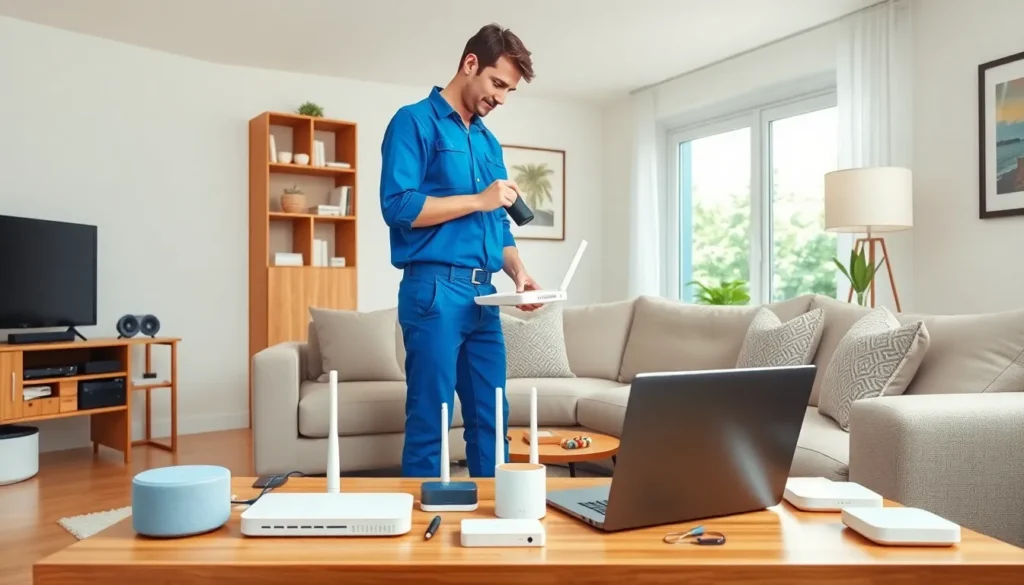Table of Contents
ToggleIn today’s digital age, a reliable home network isn’t just a luxury; it’s a necessity. Whether it’s streaming the latest binge-worthy series or ensuring that video call doesn’t turn into a pixelated mess, a solid network keeps everything running smoothly. But let’s face it—setting up a home network can feel like trying to assemble IKEA furniture without the instructions.
That’s where professional home networking installation services swoop in like tech-savvy superheroes. They take the hassle out of the equation, ensuring your Wi-Fi signal reaches every nook and cranny of your home. With their expertise, you can finally say goodbye to dead zones and buffering nightmares. So why wrestle with cables and settings when you can sit back, relax, and let the pros handle it? Your home deserves a network that works as hard as you do.
Overview of Home Networking Installation Services
Home networking installation services provide essential support for establishing a reliable digital environment. These services address the complexities of setting up an efficient network tailored for modern digital demands.
Importance of Home Networking
Home networking plays a crucial role in today’s connected lifestyle. With multiple smart devices needing a stable internet connection, having a solid network becomes essential. Houses equipped with robust networks enable seamless streaming, online gaming, and remote work. Without reliable connectivity, interruptions can frustrate users during video calls or music streaming. A well-structured network supports the increasing number of devices in a household. Strong Wi-Fi signals enhance productivity and leisure, making home networking indispensable.
Benefits of Professional Installation
Professional installation offers several advantages for homeowners. Experts ensure optimal network performance that meets specific needs. They assess the home layout and recommend the best equipment for maximum coverage. Avoiding common pitfalls, technicians configure routers and access points to eliminate dead zones effectively. Homeowners benefit from expert advice on security measures to protect their network from cyber threats. Additionally, professional installation includes troubleshooting and support, providing peace of mind. Investing in these services leads to a more reliable, user-friendly home network, enhancing overall digital experiences.
Types of Home Networking Solutions

Home networking solutions optimize digital experiences in a connected lifestyle. Two primary options exist: wired and wireless networking.
Wired Networking Options
Wired networking employs Ethernet cables for direct connections. This method provides reliable and high-speed internet access. Homeowners often benefit from reduced latency and increased security with wired setups. It suits environments with multiple devices requiring stable connections. For example, gaming consoles and desktop computers thrive on wired connectivity. Professionals installing these systems assess the home layout and recommend appropriate cable types, such as Cat6 or Cat7 cables. Quality installation ensures efficient data transmission, crucial for streaming and heavy internet usage.
Wireless Networking Options
Wireless networking facilitates internet access through Wi-Fi technology. This method allows devices to connect without cables, enhancing flexibility for mobile devices and smart gadgets. Homeowners enjoy the convenience of connecting laptops, tablets, and smartphones throughout the house. Advanced routers support higher frequencies, boosting speed and range. Mesh networks represent a popular choice for large homes, eliminating dead zones. Professional installation ensures optimal placement of routers and access points, maximizing signal strength. With the growing number of smart home devices, wireless solutions adapt to support increased connectivity needs efficiently.
Choosing the Right Service Provider
Selecting a reliable service provider for home networking installation requires careful consideration. Several factors influence the choice.
Factors to Consider
Experience matters significantly. Providers with years in the industry understand complex networking issues. Certification also plays a role. Ensure the company employs certified technicians who demonstrate expertise. Reputation is essential as well. Positive reviews and testimonials can indicate reliability and customer satisfaction. Additionally, offered services should align with individual needs. Some homeowners prioritize security features, while others focus on speed or coverage. Cost also impacts decisions. Comparing quotes alongside services ensures value for investment.
Questions to Ask
Asking the right questions aids in evaluating service providers. Inquire about their installation process. Understanding the steps they take will clarify expected timelines. Also, ask about equipment recommendations. Knowledgeable providers should suggest equipment based on specific home requirements. Support services should be discussed beforehand. Understanding if ongoing support is available helps in managing future issues. Additionally, clarify warranty details. Knowing what warranties cover and their lengths provides peace of mind. Finally, request references. Speaking to past clients gives insight into the provider’s quality and customer service.
Installation Process
The installation process for home networking involves several crucial steps. These steps ensure a seamless and efficient setup that meets the demands of modern digital lifestyles.
Initial Assessment
Providers start with an initial assessment, determining the home’s specific networking needs. This assessment includes evaluating the layout of the house and understanding the number of devices that require connectivity. Technicians identify potential obstacles and dead zones, which helps in formulating a tailored networking plan. Homeowners receive recommendations based on their internet usage patterns, ensuring the right solutions are in place for streaming, gaming, or remote work.
Equipment Setup
After the assessment, the next step is equipment setup. Technicians install routers, switches, and cabling as necessary. Each piece of equipment plays a vital role in creating a robust network. For wired setups, Ethernet cable connections are made to ensure minimal latency and high speeds, particularly for stationary devices. Wireless setups require strategic router placement to maximize coverage and eliminate dead zones. Proper installation of all these components is essential for a strong network backbone.
Network Configuration
The final step in the process involves network configuration. Configuring settings allows devices to connect seamlessly to the network. Technicians personalize Wi-Fi names and passwords, enhancing security. They also set up necessary firewall protections to safeguard against external threats. Regular updates and firmware installations ensure the network remains efficient and secure. Following configuration, a full system test confirms that all devices are connected and performing optimally, guaranteeing a reliable user experience.
Common Issues and Troubleshooting
Home networking issues often arise, impacting connectivity and performance. Addressing these problems quickly ensures a smooth digital experience.
Connectivity Problems
Connectivity problems commonly include slow internet speeds or complete outages. Factors influencing these issues often involve interference from walls or nearby electronic devices. Signal strength can weaken as distance from the router increases, causing interruptions. Network congestion often affects multiple devices trying to connect simultaneously. Checking device compatibility with the router’s specifications typically resolves these concerns. Rebooting equipment might also restore proper functionality. If problems persist, adjusting the router’s channel or frequency band can enhance performance.
Performance Optimization
Performance optimization plays a vital role in ensuring a seamless experience. Homeowners can improve speeds by placing routers in central locations, minimizing obstructions. Upgrading to a mesh network often eliminates dead zones, especially in larger homes. Bandwidth allocation for specific devices might also help prioritize critical tasks. Regularly updating firmware on networking equipment ensures compatibility and enhances security. Monitoring network traffic can identify and troubleshoot problems effectively. Seeking professional support for advanced configurations can further optimize setups.
Investing in professional home networking installation services is a smart choice for anyone looking to enhance their digital experience. With the increasing reliance on stable internet connections for various activities, having experts handle the setup ensures optimal performance and coverage. They provide tailored solutions that address individual needs while minimizing common issues like dead zones and slow speeds.
By choosing the right service provider, homeowners can enjoy a seamless network that supports multiple devices and demands. The peace of mind that comes with expert installation and ongoing support makes it a worthwhile investment for a connected lifestyle. Embracing professional services not only simplifies the process but also elevates the overall efficiency of home networking.







